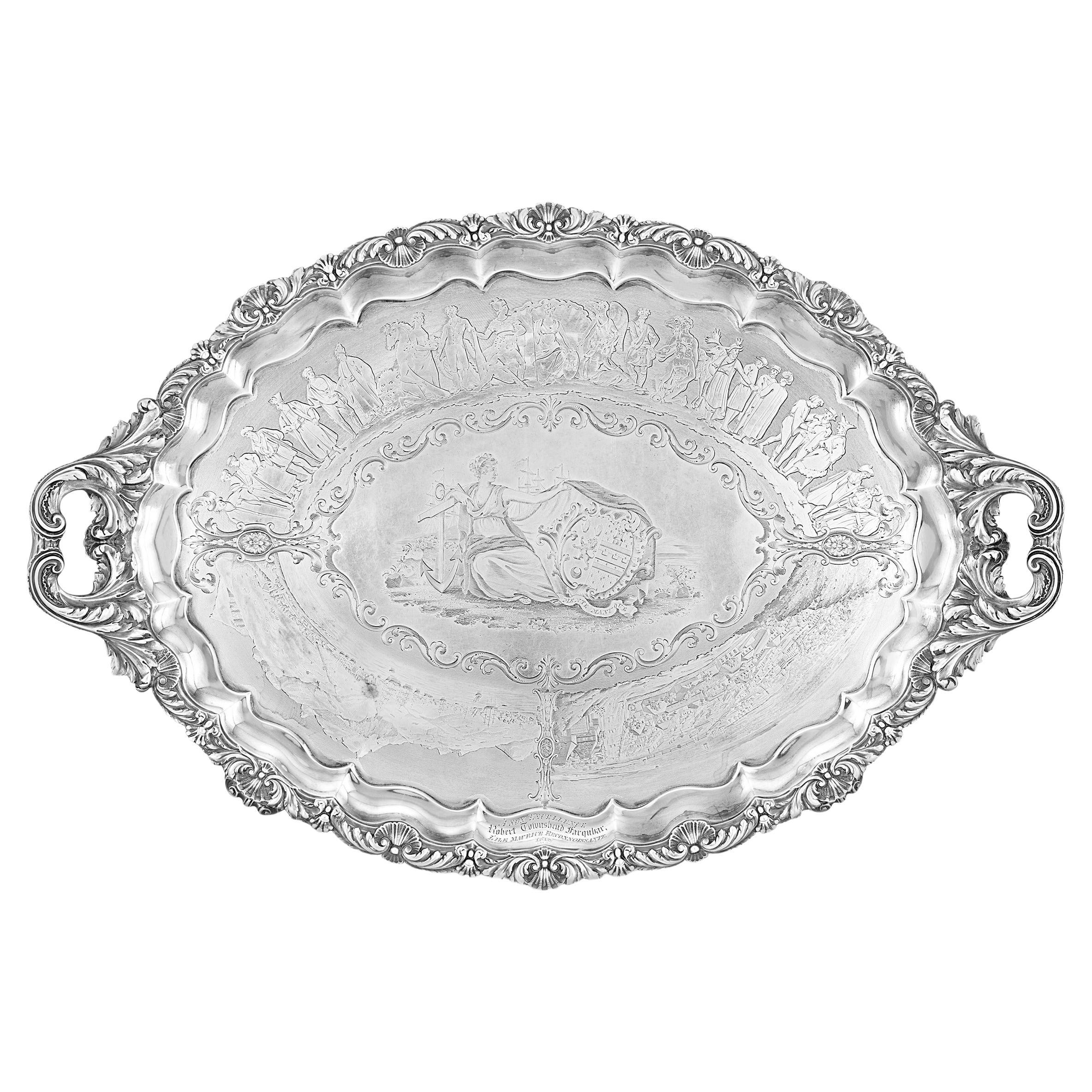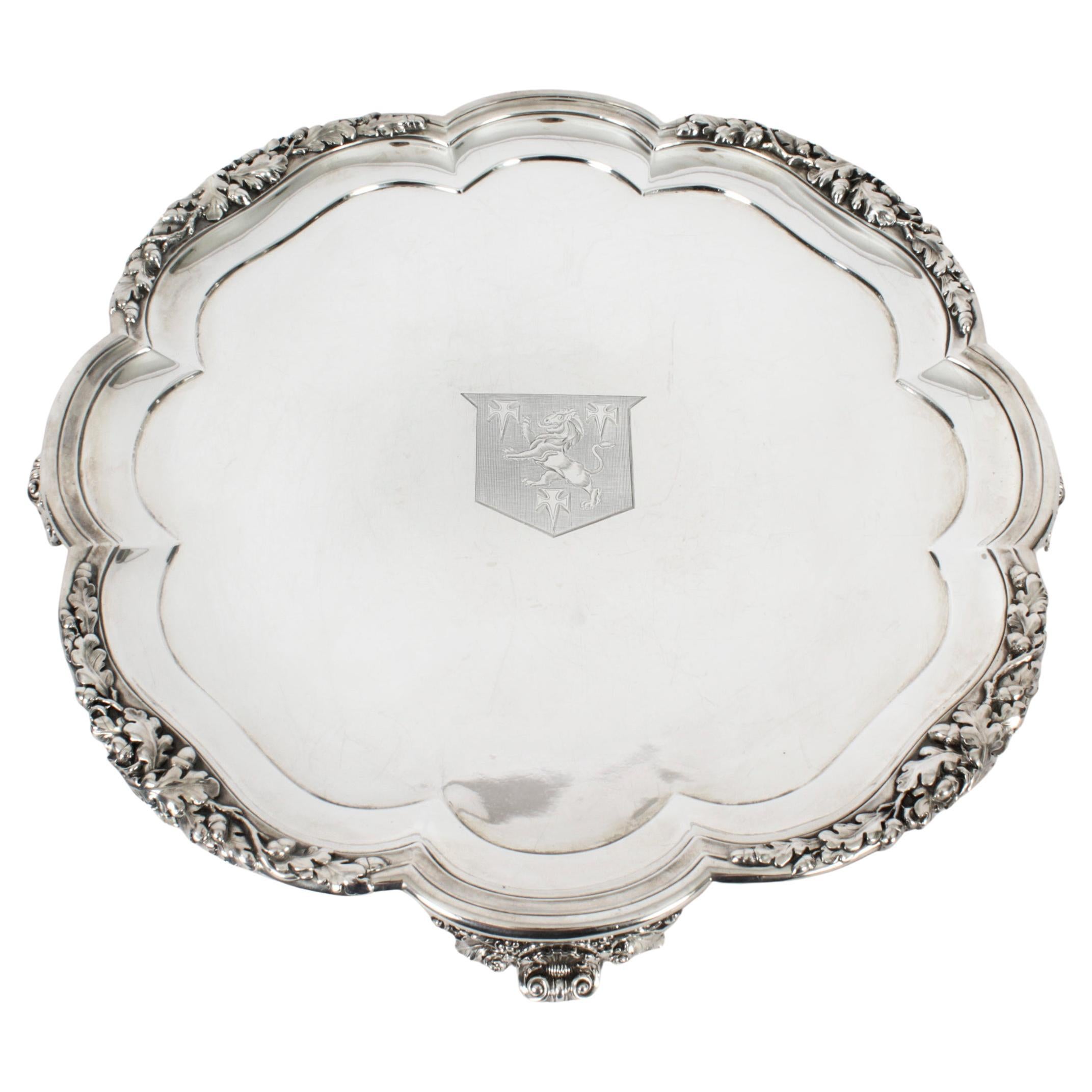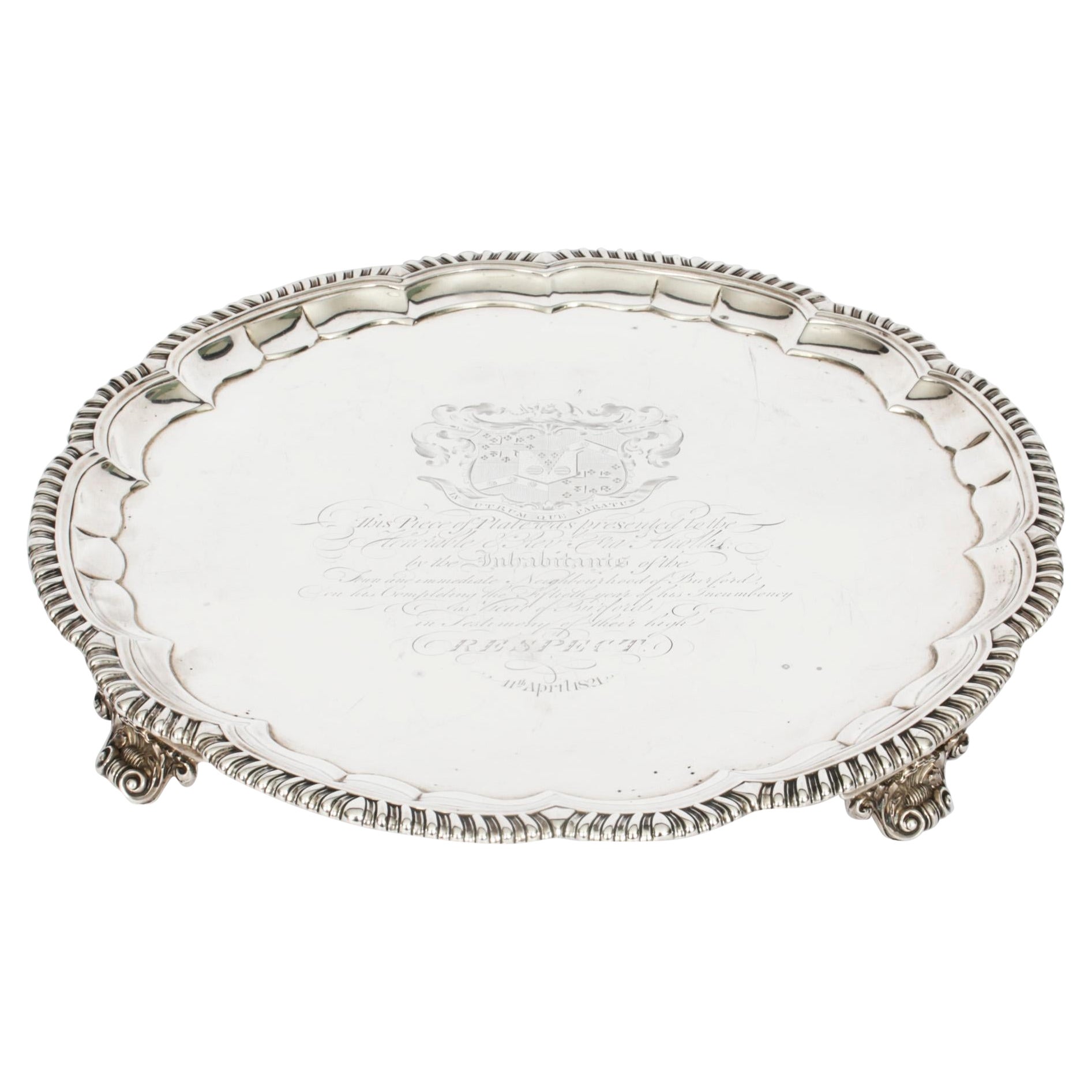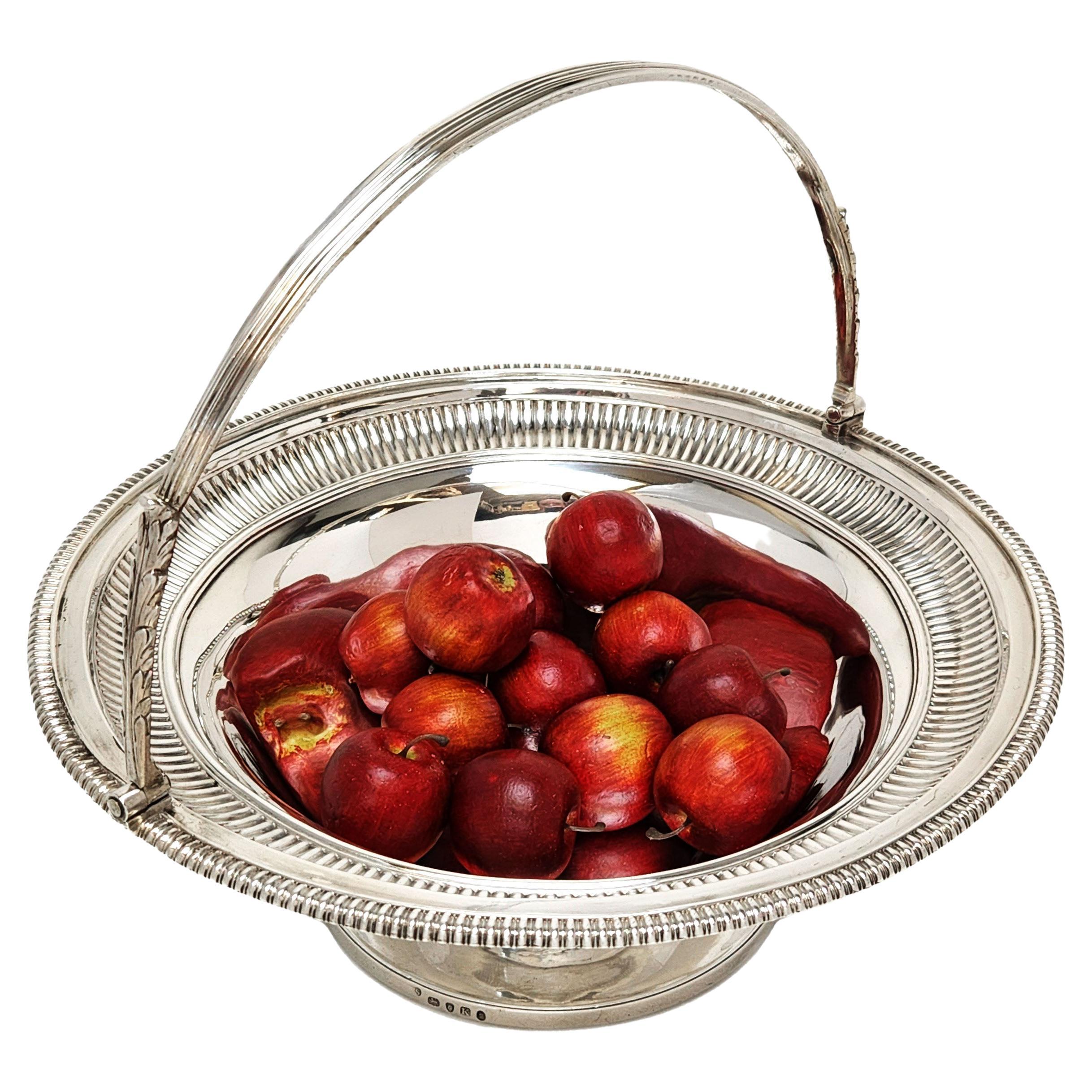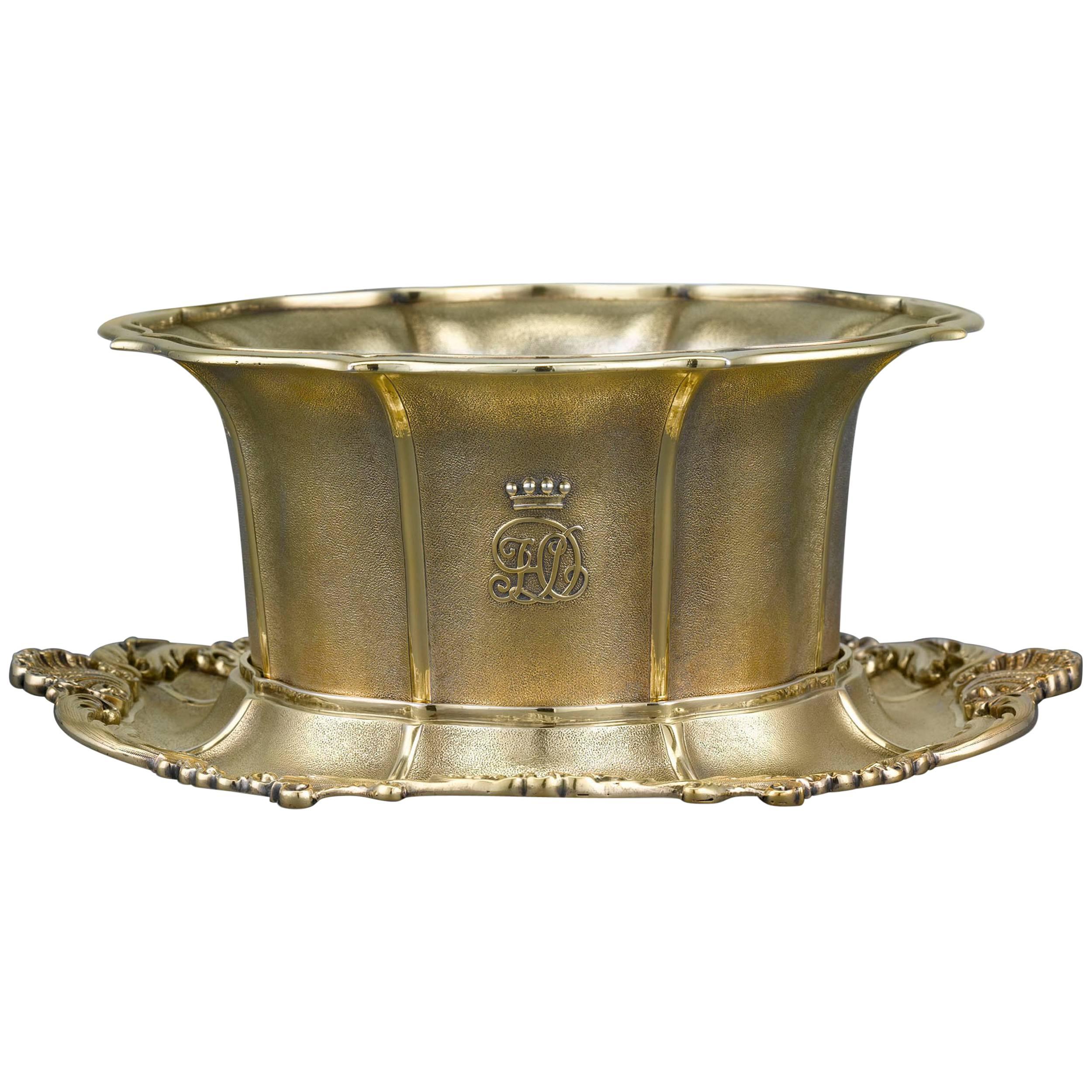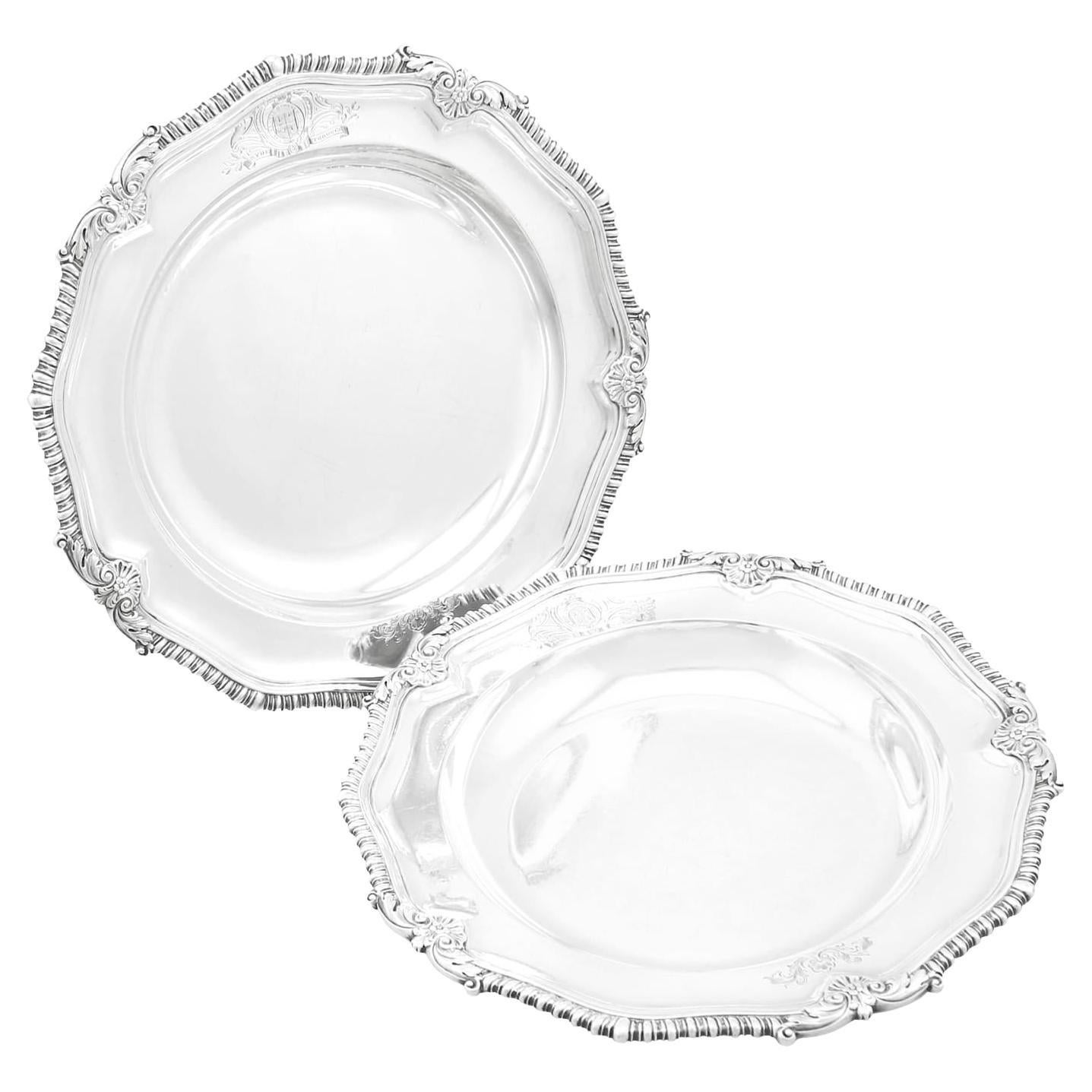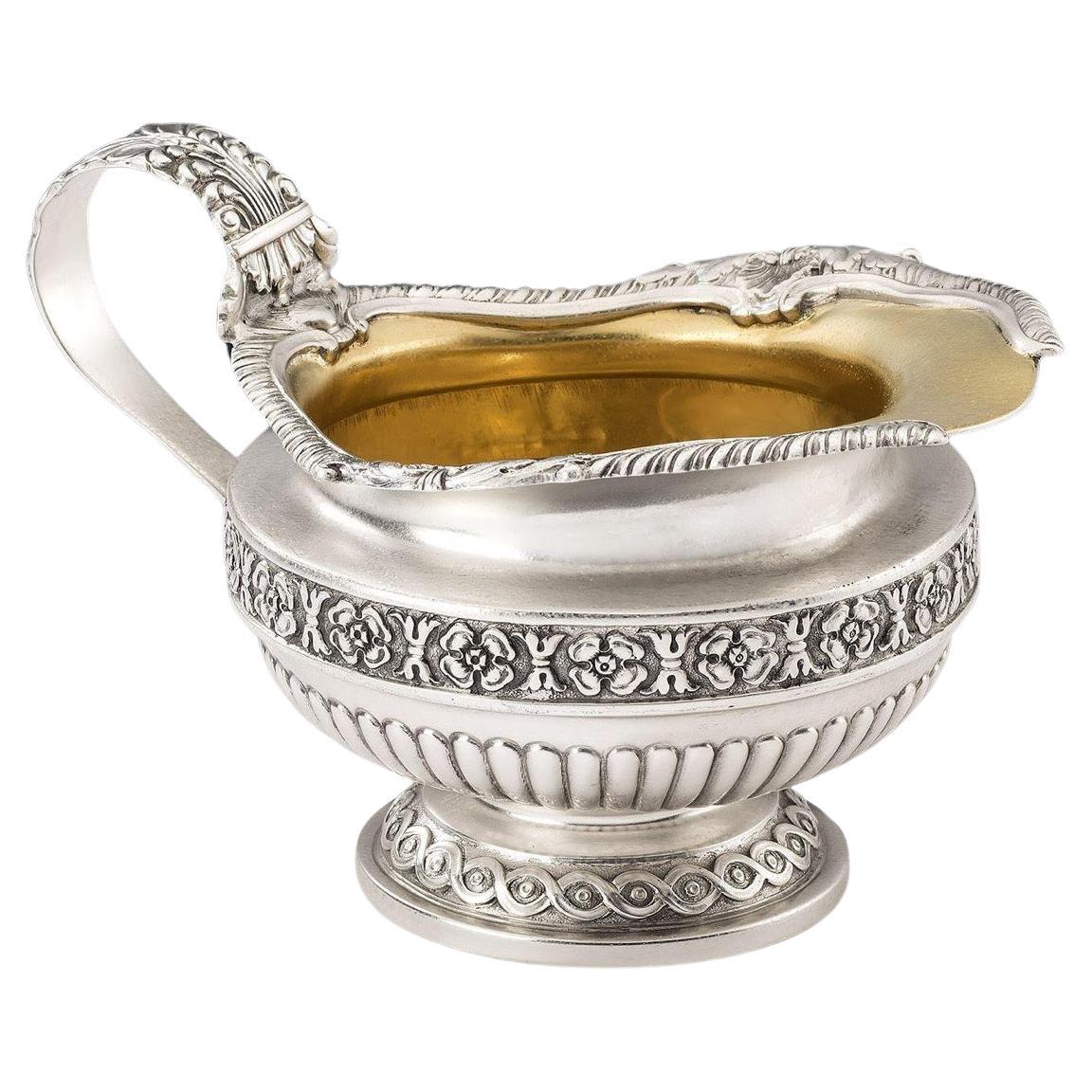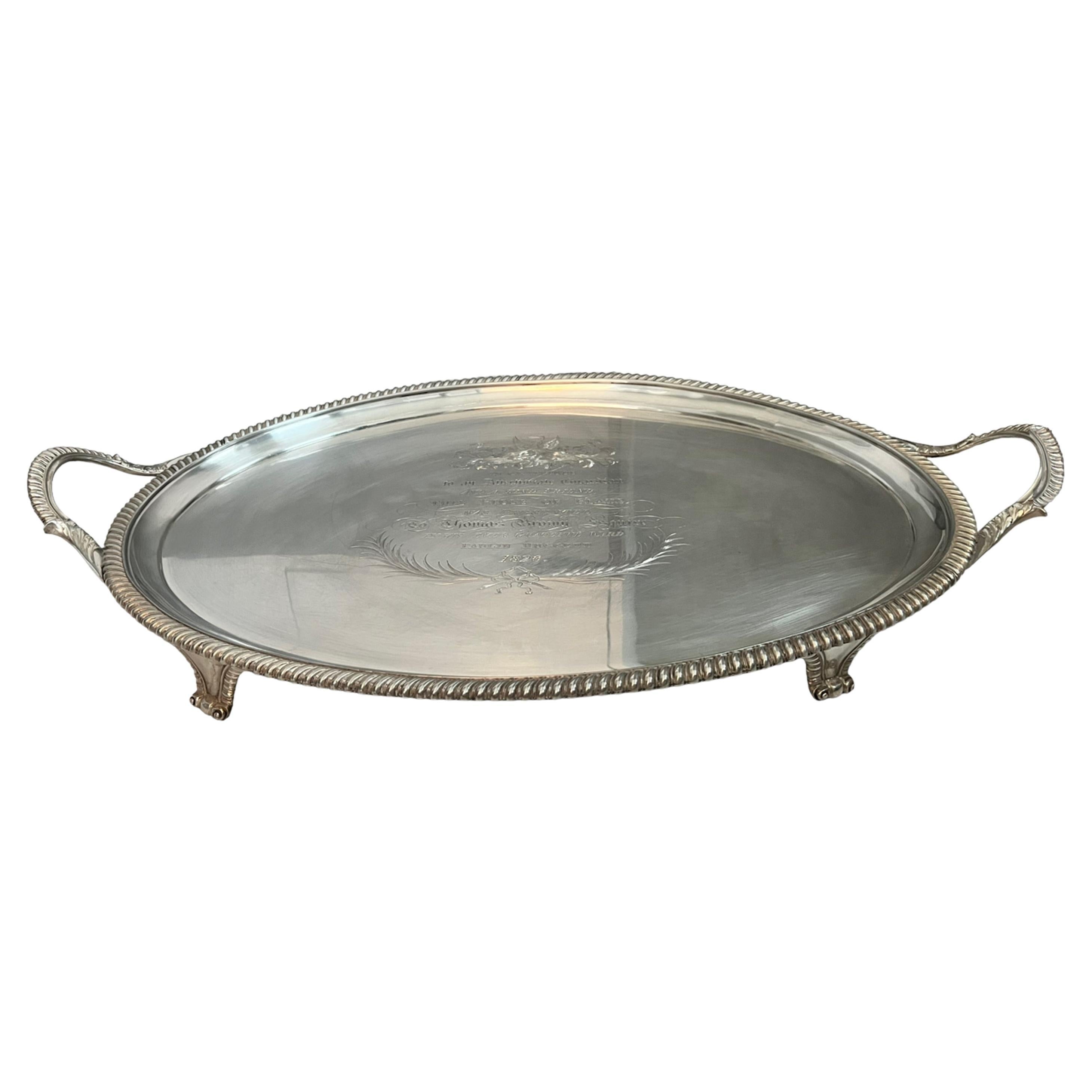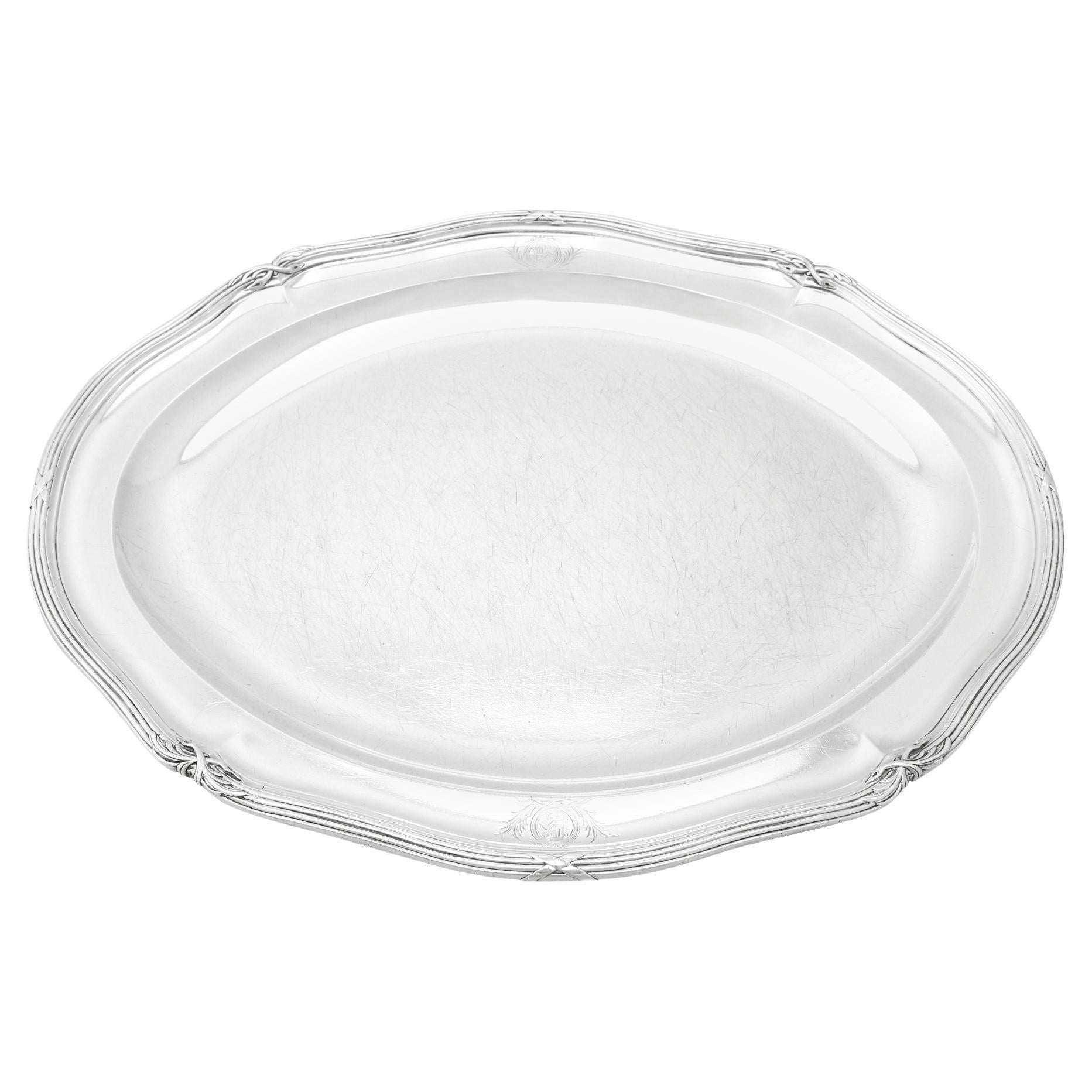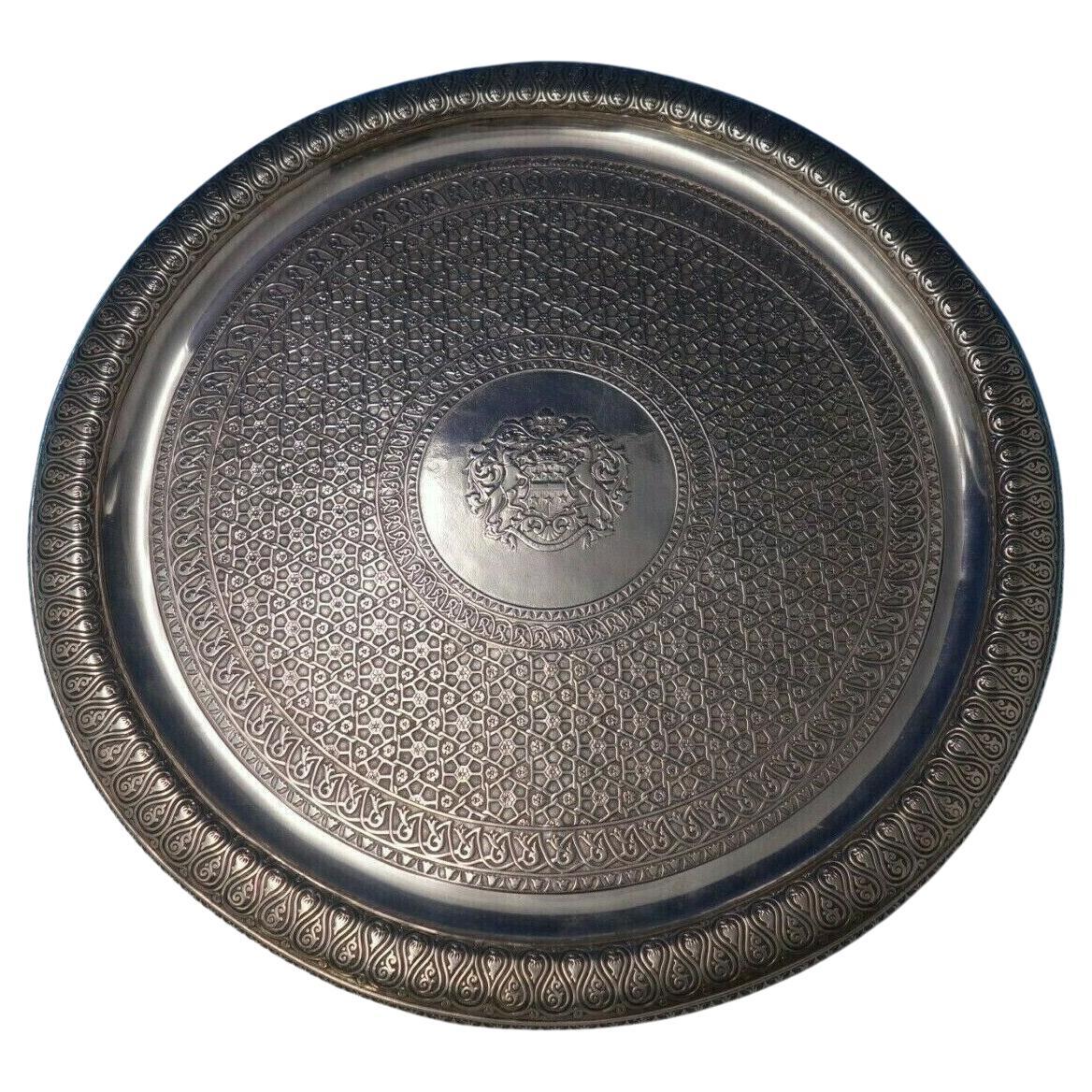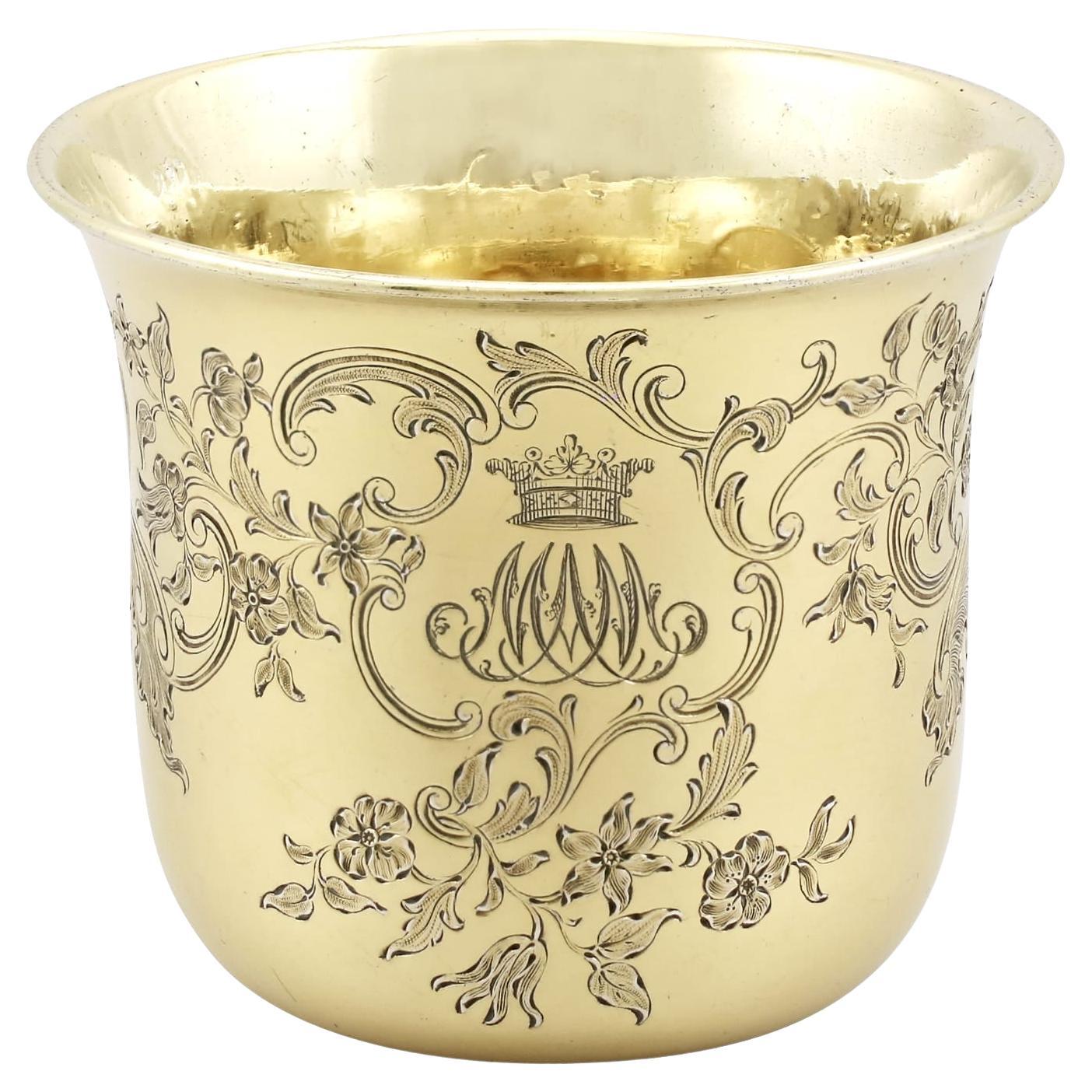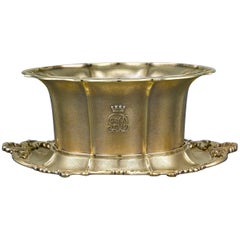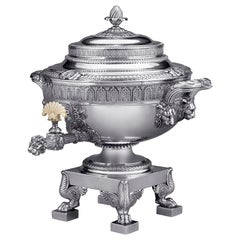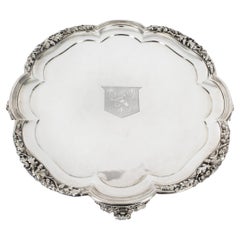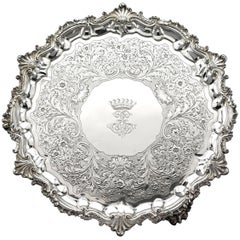
William IV Silver Tray by Paul Storr
View Similar Items
Want more images or videos?
Request additional images or videos from the seller
1 of 5
William IV Silver Tray by Paul Storr
About the Item
- Creator:Paul Storr (Maker)
- Dimensions:Height: 1.88 in (4.78 cm)Diameter: 18 in (45.72 cm)
- Style:Regency (Of the Period)
- Materials and Techniques:
- Place of Origin:
- Period:
- Date of Manufacture:1835
- Condition:
- Seller Location:New Orleans, LA
- Reference Number:Seller: 30-26571stDibs: LU89115083773
About the Seller
5.0
Recognized Seller
These prestigious sellers are industry leaders and represent the highest echelon for item quality and design.
Established in 1912
1stDibs seller since 2010
Typical response time: 5 hours
More From This SellerView All
- Paul Storr Commemorative Silver TrayBy Paul StorrLocated in New Orleans, LAThis highly important sterling silver tray by famed English silversmith Paul Storr was gifted by the isles of Mauritius to its famed abolitionist leader, Sir Robert Townsend Farquhar...Category
Antique 19th Century English Regency Platters and Serveware
MaterialsSilver, Sterling Silver
- Paul Storr Silver-Gilt BowlBy Paul StorrLocated in New Orleans, LAThis rare and exceptional William IV bowl is the work of preeminent Georgian silversmith Paul Storr. Crafted of luxurious gilt silver, the bowl exhibits all the hallmarks of Storr’s celebrated style, from the textured panels and applied decorations to the ruffled scallop shells and acanthus adorning its matching, fitted underplate. Paul Storr was a master at redefining and perfecting Georgian, Regency and William IV silver. His works have remained the most desirable with collectors for generations, and many have been given as prizes in refined competitions. Elegant and sumptuous, this bowl was later awarded as First Prize in a backgammon tournament in 1972. Paul Storr was a master at redefining and perfecting Georgian, Regency and William IV silver. Although he created items of great extravagance, some of his most captivating designs exhibited his restrained yet refined sensibilities. His works have remained the most desirable with collectors for generations and many have been given as prizes in refined competitions. Later presentation inscription “Clermont Club Grand International Backgammon Tournament April 1972 First Prize” Hallmarked London, 1836 on bowl and stand; stand numbered 435 Bowl: 8 ¼” diameter x 3 3/8” high Stand: 10” diameter 38.2 troy ounces The Clermont Club, located on London’s aristocratic Berkeley Square in Mayfair, is one of the most exclusive gaming clubs in the world. The club is housed in the only surviving town house designed by renowned Georgian architect William Kent, and the architecture and interiors make it one of the most elegant clubs in existence. The list of the club's original members included the cream of the British aristocracy...Category
Antique 19th Century English William IV Serving Bowls
MaterialsSilver
$28,500 - 19th Century Paul Storr Silver Tea UrnBy Paul Storr, Rundell, Bridge & RundellLocated in New Orleans, LAThis extraordinarily rare and masterfully crafted tea urn is by the hand of the master Georgian silversmith Paul Storr. Created by Storr while working for Rundell, Bridge and Rundell, Jewelers and Goldsmiths to the King, this magnificent piece truly represents the sophisticated style of the renowned firm and the enormous talents of Paul Storr. Applied and engraved decoration envelop this masterpiece equipped with a carved handle, lion's head spigot and spectacular lion's paw supports. The piece bears the arms of the Neave Baronetcy with those of Digby, for Sir Thomas Neave and his wife Frances Caroline, daughter of the Hon. William Digby, the Dean of Durham. Though he held no formal title, Storr enjoyed patronage from the most important and powerful figures of the period including King George III and the Prince of Wales, the future King George IV. His first major work was a gold font commissioned by the Duke of Portland in 1797, and in 1799 he created the “Battle of the Nile...Category
Antique 19th Century English Georgian Sterling Silver
MaterialsSilver
- Paul Storr Silver-Gilt Grape ShearsBy Paul StorrLocated in New Orleans, LAAn incredibly rare and exceptional pair of grape shears by Paul Storr, one of the most esteemed silversmiths in history. With handles laden with grapevine...Category
Antique 19th Century English Regency Serving Pieces
MaterialsSilver
- George III Silver Tray for Lt. Robert ChesterBy Hannam & CrouchLocated in New Orleans, LAThis fascinating George III silver tray is a work of skillful English artistry, intricately chased and engraved it represents a prestigious commemorative gift for service. The tray rests on 4 bracket feet with oval handles and a delightful gadrooned border. The tray is distinguished by a spectacular engraved inscription of unmatched quality that bears a presentation inscription. The inscription is surrounded by a laurel wreath border with arms, two coat of arms and flags, two of which bear the monograms for King George III and George Spencer...Category
Antique Early 19th Century English George III Platters and Serveware
MaterialsSilver
- Bangor Pattern Tray by Jewel Cut Glass CompanyLocated in New Orleans, LAThe Bangor pattern adorns this American Brilliant Period cut glass bowl by the Jewel Cut Glass Company. Cut with a high level of precision, the pattern features a richly detailed hob...Category
Early 20th Century American Other Glass
MaterialsCut Glass
You May Also Like
- Antique Large William IV Silver Tray Salver by Paul Storr 1837 19th CenturyBy Paul StorrLocated in London, GBThis is a wonderful English antique William IV sterling silver tray, or salver, by the world famous silversmith Paul Storr. It has clear hallmarks for London 1837 the makers mark of Paul Storr and is also engraved Storr & Mortimer 36, they were Goldsmiths and Jewellers to Her Majesty’ (1822-1839). It is typical of his work with the octafoil shape and the exquisitely detailed foliate and acorn rim. It is raised on four delightful foliate and scroll feet. The centre is engraved with a shield shaped coat of arms encompassing the lion rampant which I have had researched: The Arms of the Family of King The arms as engraved upon this William IV English Sterling Silver Footed Salver by Paul Storr hallmarked London 1837 are those of the family of King. They may be blazoned as follows: Arms: Sable a lion rampant between three crosses formy fitchy argent Undoubtedly this salver was in the possession of a gentleman who was member of a family bearing the name of King. There are a number of variants of these armorial bearings being borne by King families. Very often the lion is of a different tincture but the field of the shield is invariably remains ‘sable’. Similar arms and crest were recorded by Sir Edward Bysshe, Clarenceux King of Arms in his Visitation of the County of Kent of 1663 to the family of King, of Bromley. The tinctures of both arms and crest of King, of Bromley were slightly different to those engraved upon this tureen in that the Visitation family’s arms were ‘Sable a lion rampant ermine between three crosses paty fitchy or’ 1 and the crest ‘A lion’s gamb erect and erased sable holding a cross paty fitchy or’(see illustration below). These arms and crest were granted by Sir Edward Walker, Garter King of Arms on the 20th February 1660 – 61; and yet another Kentish family of King, of Bellevue who were created Baronets within the Baronetage of Great Britain in 1792 bore for their arms ‘Sable a lion rampant erminois between three crosses paty fitchy or’. Their crest being the same as the family of King, of Bromley. There is no mistaking its unique quality and design, which is sure to make it a treasured piece by any discerning collector. Please see potos of the 2nd Baronet Timothy Shelley, 1753-1844 and Castle Goring, his home. Condition: In excellent condition with clear hallmarks and no dings, dents or signs of repair. Please see photos for confirmation. Dimensions in cm: height 4 x width 44 x depth 44 Weight 1.96 kg Dimensions in inches: height 2 inches x width 1 foot, 5 inches x depth 1 foot, 5 inches Weight 63 troy oz Paul Storr born in London England in 1771, was to become one of the most talented silversmiths of the nineteenth century. Today his legacy of exceptionally well crafted silver, found worldwide in museums and private collections, leaves one in awe when compared to that of his contemporaries.After having served a seven year apprenticeship from the age of 14, he began his career in 1792 when he went into a brief partnership with William Frisbee. This did not last and in 1793 a new mark, (his initials ‘P S’) was entered. By the beginning of the nineteenth century he had established himself as one of London’s top silversmiths producing, amongst others, commissions for Royalty. In 1801 he married Elizabeth Susanna Beyer with whom he was to have ten children. In 1807 Paul Storr entered into a working relationship with Philip Rundell and by 1811 was a partner, and managing the workshops for Rundell, Bridge & Rundell. During this period he kept his own marks and separate workshop. However it was through Rundell, Bridge & Rundell who were appointed Goldsmith in Ordinary to George III in 1804 that his reputation as a master silversmith grew. His talents lay in being able to transform ideas and designs from Rundell, Bridge & Rundell’s designers, William Theed...Category
Antique 1830s English William IV Sterling Silver
MaterialsSterling Silver
- Antique Large William IV Silver Tray Salver by Paul Storr 1820 19th CenturyBy Paul StorrLocated in London, GBThis is a wonderful English antique William IV sterling silver tray, or salver, by the world famous silversmith Paul Storr. It has clear hallmarks for London 1820 the makers mark of Paul Storr. It is typical of his work with the octafoil shape and the exquisitely detailed reeded rim, and it is raised on four delightful foliate and scroll feet. The centre is engraved with a shield shaped coat of arms which I have had researched. The Marital Arms of Knollis and Hallifax The armorial bearings as engraved upon this George IV Large English Sterling Silver Footed Salver by Paul Storr hallmarked London 1820 are those of the family of Knollis with Hallifax in pretence. These armorial bearings denote the marshalling of a marital coat showing the arms of the husband over the entire surface of the shield, whilst the arms of the wife (as an heraldic heiress) are placed on a small shield (known as an escutcheon of pretence) centrally on the husband’s arms. They may be blazoned as follows: Arms: Quarterly 1st and 4th Azure crusily of cross crosslets a cross moline voided or (for Knollys) 2nd and 3rd Gules on a chevron argent three roses of the field barbed proper (for Knollys) over all an escutcheon of pretence Or on a pile engrailed sable between two fountains barry wavy of six argent and azure three cross crosslets of the first (for Hallifax) Crest: An elephant argent [differenced with a mullet1 ] (for Knollys) Motto: In utrumque paratus [Prepared for either] (for Knollys) These armorial bearings undoubtedly commemorate the marriage of The Honourable and Reverend Francis Knollis2 (baptised 3rd January 1743 died 27th February 1826), 1 The cadency mark for a third son of a family. 2 Francis appears to have preferred this spelling of his family’s surname. It is spelt as it is to be pronounced. of Burford in the County of Oxfordshire and of Eastleach Martin in the County of Gloucestershire and Mary Hallifax (baptised 5th March 1753 buried 18th December 1830). Francis and Mary were married at the Parish Church of St Mary, Ewell in the County of Surrey on the 9th June 1772. Francis was the third son of Charles Knollys (the titular 5th Earl of Banbury) 3 and his wife, Martha Hughes, whilst Mary was the daughter of The Reverend James Hallifax, of Ewell aforesaid and his wife, Elizabeth Chardavoyn. 3 Francis’s father claimed to be the 5th Earl of Banbury. A claim that continued to be pursued by the family until William Knollys, the titular 8th Earl of Banbury (born 1763 died 1834) was forced to discontinue its use by a resolution of the House of Lords which rejected his claim to the earldom in 1813. The crest surmounts a detailed dedication: This piece of plate was presented to the Honourable Rev Knolls by the inhabitants of the town and immediate neighbourhood of Burford on his completing the fiftieth year of his incumbency as the vicar of Burford. In testimony of their high respect 11th April 1821 There is no mistaking its unique quality and design, which is sure to make it a treasured piece by any discerning collector. Condition: In excellent condition with clear hallmarks and no dings, dents or signs of repair. Please see photos for confirmation. Dimensions in cm: Height 3 x Width 36 x Depth 36 Weight 1.52 kg Dimensions in inches: Height 1 inch x Width 1 foot, 2 inches x Depth 1 foot, 2 inches Weight 49 troy oz Paul Storr born in London England in 1771, was to become one of the most talented silversmiths of the nineteenth century. Today his legacy of exceptionally well crafted silver, found worldwide in museums and private collections, leaves one in awe when compared to that of his contemporaries.After having served a seven year apprenticeship from the age of 14, he began his career in 1792 when he went into a brief partnership with William Frisbee. This did not last and in 1793 a new mark, (his initials ‘P S’) was entered. By the beginning of the nineteenth century he had established himself as one of London’s top silversmiths producing, amongst others, commissions for Royalty. In 1801 he married Elizabeth Susanna Beyer with whom he was to have ten children. In 1807 Paul Storr entered into a working relationship with Philip Rundell and by 1811 was a partner, and managing the workshops for Rundell, Bridge & Rundell. During this period he kept his own marks and separate workshop. However it was through Rundell, Bridge & Rundell who were appointed Goldsmith in Ordinary to George III in 1804 that his reputation as a master silversmith grew. His talents lay in being able to transform ideas and designs from Rundell, Bridge & Rundell’s designers, William Theed...Category
Antique 1820s English William IV Sterling Silver
MaterialsSterling Silver
- Antique Georgian Paul Storr Silver Basket 1805 Swing Handled Cake BreadBy Paul StorrLocated in London, GBAn Antique George III Sterling Silver swing handled Basket. This Georgian Silver Basket has a round shape and is embellished with a simple elegant chased border and subtle acanthus l...Category
Antique Early 19th Century English Georgian Platters and Serveware
MaterialsSterling Silver
- Paul Storr Sterling Silver Soup BowlsBy Paul StorrLocated in Jesmond, Newcastle Upon TyneAn exceptional, fine and impressive pair of antique George IV English sterling silver soup plates made by Paul Storr, an addition to our ra...Category
Antique 1820s English George IV Platters and Serveware
MaterialsSterling Silver
- George IV Milk Jug Made in London in 1822 by Paul StorrBy Paul StorrLocated in London, GBA very fine George IV Milk Jug made in London in 1822 by Paul Storr. The Jug is of a large size and stands on a circular foot decorated with a raised border of entwined bands contai...Category
Antique 19th Century English George IV Platters and Serveware
MaterialsSilver, Sterling Silver
- 1823 English George IV Sterling Silver Presentation Tray by John MewburnBy John MewburnLocated in North Miami, FLCrafted in the year 1823 in London, this remarkable English George IV silver presentation tray, expertly created by the skilled silversmith John Mewb...Category
Antique 19th Century English Georgian Sterling Silver
MaterialsSterling Silver
Recently Viewed
View AllMore Ways To Browse
Antique Legacy
Silver Presentation Tray
Antique Sterling Silver Serving Tray
Paul Revere
High Border Tray
Large Sterling Silver Serving Tray
Sterling Tray Shell
Paul Revere Silver
Paul Revere Sterling
Paul Revere Silversmith
Line V Box
Sterling Book Mark
Retro Silverware Set
Spoon Feet
Georg Jensen Silver Butter
Art Deco Silver Server
Danish Sterling Tea Set
Silver With Leaves Embossed
